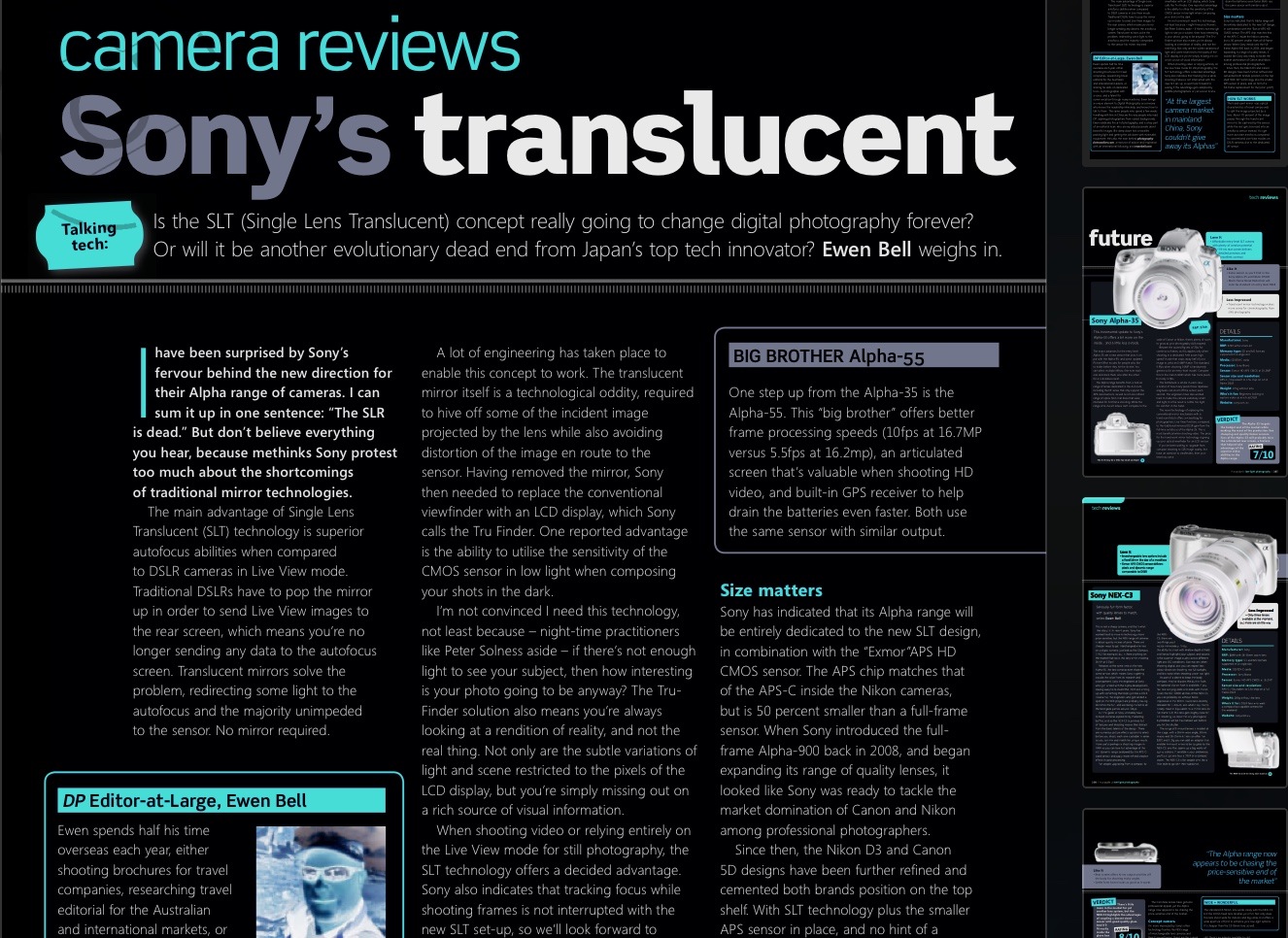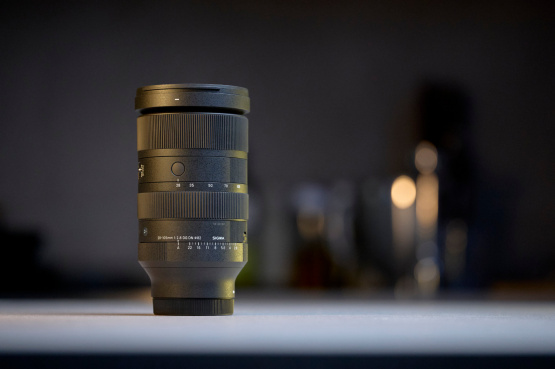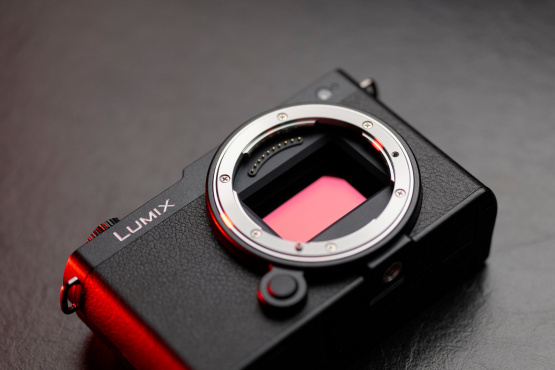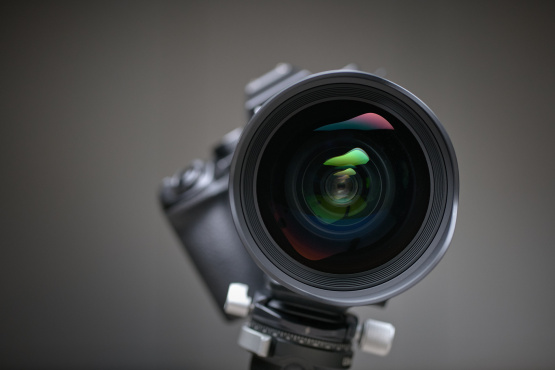NEW KID IN TOWN
I have been surprised by Sony's fervor behind the new direction for their Alpha range of cameras. I can sum it up in one sentence, "The SLR is dead." But don't believe everything you hear, because me thinks Sony protest too much about the short-comings of traditional mirror technologies.
The main advantage of SLT technology is superior autofocus abilities when compared to DSLR cameras in Live View mode. Traditional DSLR cameras have to pop the mirror up in order to send Live View images to the rear screen, and that means you're no longer sending any data to the autofocus screen. Translucent mirrors solve the problem, redirecting some light to the autofocus and the majority unimpeded to the sensor. No mirror required.
A lot of engineering has taken place to enable this concept to work. The translucent mirror itself is a technological oddity, required to hive off some of the incident image projected by the lens while also avoiding distortion of the image en route to the sensor. Having removed the mirror Sony then needed to replace the conventional viewfinder with an LCD display, which Sony call the Tru Finder. One reported advantage is the ability to utilise the sensitivity of the CMOS sensor in low light when composing your shots in the dark.
I'm not convinced I need this technology, not least because if there's not enough light to see your subject then how interesting is your photo going to be anyway? The Tru-Finder solution also means you're always looking at a rendition of reality, and not the real thing. Not only are the subtle variations of light and scene restricted to the pixels of the LCD display, but you're simply missing out on a rich source of visual information.
When shooting video or relying entirely on the Live View mode for still photography the SLT technology offers a decided advantage. Sony also indicate that tracking focus while shooting frames is not interrupted with the new SLT setup, so we'll look forward to seeing if this advantage gets adopted by wildlife photographers or just soccer mums.
SIZE MATTERS
Sony have indicated that their Alpha range will be entirely dedicated to the new SLT design, in combination with the "Exmor" APS HD CMOS sensor. The APS chip matches that of the APS-C inside the Nikon cameras, but is 50% smaller than a full-frame sensor. When Sony introduced the full-frame Alpha-900 back in 2008, and began expanding their range of quality lenses, it looked like Sony were ready to tackle the market domination of Canon and Nikon amongst professional photographers.
Since then the Nikon D3 and Canon 5D designs have been further refined and cemented both brands position on the top shelf. With SLT technology plus the smaller APS sensor in place, and no hint of a full-frame replacement for the Alpha-900, it seems Sony now have their sights set on the consumer market instead.
Less than 9 months ago I attended the largest camera market in mainland China, and watched in amazement as Sony couldn't even give away their Alphas. Pretty young girls grabbed passing consumers at the door, thrusting specifications and cameras into their hands, but the punters just walked past in search of Nikon and Canon stalls. Photographers are intensely brand loyal and despite the excellent reviews of early Alpha products, and handsome looking specifications, most buyers just weren't willing to take a gamble.
Australian buyers have been a little more tolerant, but only a little. Sony have a reputation for rapid innovation followed by rapidly moving to the next innovation, and leaving their consumers holding the digital baby. I'm glad I didn't buy an Alpha-900 a few years ago, because at this point there is no indication from Sony that they intend to build another full frame DSLR. It's a shame because Carl Zeiss have built some excellent lenses for the A-mount, capable of delivering superb quality images to a much larger sensor than the APS format in the new Alpha-35.
The Carl Zeiss lenses have genuine professional appeal, yet the Alpha range now appears to be chasing the price sensitive end of the market.
CONCEPT CAMERA
I'm more impressed by Sony's other technology frontier, the NEX range of interchangeable lens cameras and their E-mount lenses, than I am the current direction to embed translucent mirrors in the Alpha range. The latest NEX-C3 is a lovely bit of technology that echoes the best of Sony's core skills. Form factor, interface and innovative design bring a large sensor into a beautifully small package. These E-mount lenses will form the basis for future product development in stills and video, and open the door to whole new industrial design possibilities. The NEX-C3 is the closest thing to watching a concept car roll off the production line, and it uses the exact same APS sensor that you'll find in the recently released Alpha-35.
Founding the E-mount platform was a brave move by Sony given the growing success of the "Four Thirds" format, which offers low-cost interchangeable lens systems to the consumer market. But size matters, and a bigger sensor specification will forever give the E-mount models an advantage. Put the 16mm wide angle lens onto the NEX-C3 and you have a stealthy camera for urban action, indoors and out, bristling with technology and crammed with consumer focused features. Better still, there's an adaptor available to slot those lovely A-mount Carl Zeiss lenses onto the E-mount slot.
Presently the breadth of E-mount lenses are modest to say the least, with just three to choose from, but six more are on the way. The baby of the pack is a 16mm lens that offers the equivalent of 24mm on a full-frame SLR, and it's tiny. Stack this combination up against the Leica X1 or Fuji X100 and you have a real choice to make, all of them with generous sensors behind quality glass bringing wide perspectives and wide apertures. Where the Leica and Fuji models sport retro styling, only the NEX gives you interchangeable lenses with an APS-C sized sensor while still making you look uber-trendy as you sip a cafe latte in some inner-city laneway.
It is worth noting that the menu system on both the NEX and SLT models is very basic and very clumsy, but if Sony can keep improving the hardware then there's hope for the firmware too.
The new direction of Sony's Alpha range and the SLT concept is probably most interesting if you're looking to shoot videos instead of photographs. The NEX range however has got my attention, because we all know that good things come in small packages.
CONCLUSION
Claims that SLT technology will have the big boys jumping to get onboard are all part of the marketing hype around what is essentially a solution looking for a problem. For stills photography the SLT technology introduces more questions than answers. Far more exciting than the cloak and mirrors of the Alphas are the geek credentials of NEX – some funky technology that looks as good as it works.

Keep Reading
Join Ewen's newsletter for monthly updates on new photography articles and tour offers...Subscribe Here









